Geography Playlist
19 chapters • 0 completed
The Universe and the Earth
18 topics
Atmosphere and its composition
6 topics
Atmospheric Temperature
11 topics
Atmospheric Moisture
9 topics
Air Mass, Fronts & Cyclones
15 topics
Evolution of Earths Crust, Earthquakes and Volcanoes
23 topics
Interior of The Earth
14 topics
Landforms
25 topics
Geomorphic Processes
10 topics
Movement of Ocean Water
16 topics
Oceans and its Properties
12 topics
Climate of a Region
14 topics
Indian Geography - introduction, Geology
5 topics
Physiography of India
27 topics
Indian Climate
20 topics
Indian Drainage
32 topics
Soil and Natural Vegetation
13 topics
Mineral and Energy Resources, Industries in India
28 topics
Indian Agriculture
22 topics
Chapter 8: Landforms
Chapter TestAction of River Water – Basic Concepts
Rivers are dynamic systems shaped by gravity, draining precipitation from their source to their mouth. They form networks of tributaries, distributaries, drainage basins, and watersheds, playing a central role in shaping landscapes and human settlements.
Rivers are dynamic systems shaped by gravity, draining precipitation from their source to their mouth. They form networks of tributaries, distributaries, drainage basins, and watersheds, playing a central role in shaping landscapes and human settlements.
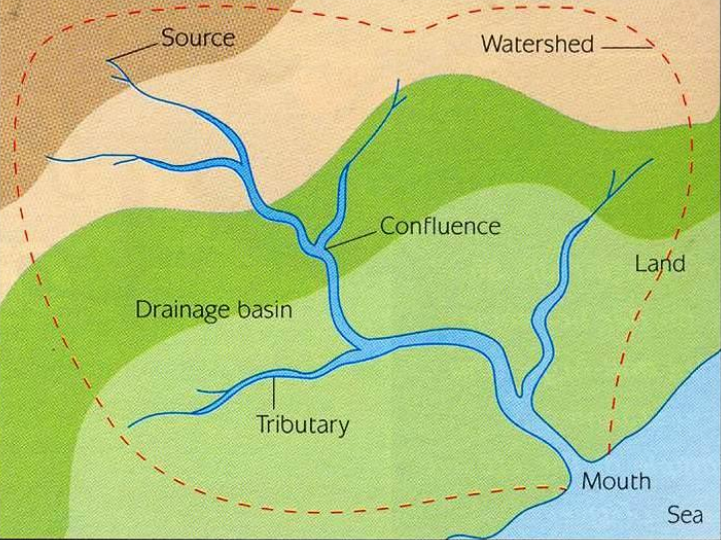
Key Terms in River System
| Term | Definition | Example |
|---|---|---|
| River | Flowing body of water moving under gravity | Ganga, Nile, Amazon |
| Source | Point of river’s origin | Gangotri Glacier (Ganga), Lake Victoria (Nile) |
| Mouth | Where river ends into sea/lake/ocean | Ganga into Bay of Bengal |
| Tributary | Stream joining a larger river | Yamuna (tributary of Ganga) |
| Confluence | Meeting point of rivers | Allahabad/Prayagraj – Ganga, Yamuna, Saraswati |
| Distributary | Branch flowing away from main river | Hooghly (from Ganga) |
| Drainage Basin | Area draining water into one river | Amazon Basin |
| Watershed | Boundary separating basins | Western Ghats (separates Arabian Sea & Bay of Bengal basins) |
Mains Key Points
Prelims Strategy Tips
Types of Drainage System – Sequent and Insequent
Drainage systems describe the pattern of river networks shaped by slope, structure, and geology. They are broadly classified into sequent drainage systems, which follow the land slope, and insequent systems, which develop without regard to structure or slope.
Drainage systems describe the pattern of river networks shaped by slope, structure, and geology. They are broadly classified into sequent drainage systems, which follow the land slope, and insequent systems, which develop without regard to structure or slope.
Types of Sequent Drainage Systems
| Type | Description | Example |
|---|---|---|
| Consequent | Rivers follow natural slope of land | Godavari, Krishna, Cauvery |
| Subsequent | Streams developed later due to erosion in weaker rocks | River Asan (tributary of Yamuna) |
| Obsequent | Streams flow opposite to consequent rivers | North-flowing tributaries of Ganga (Siwaliks) |
| Resequent | Streams follow consequent direction but are younger | Younger streams in Peninsular India |
Mains Key Points
Prelims Strategy Tips
Insequent Drainage System and Drainage Patterns
Insequent drainage systems are river systems that do not follow the normal land slope but cut across geological structures. They are classified into antecedent (inconsequent) and superimposed systems. Drainage patterns, on the other hand, describe the geometric arrangements of rivers and tributaries in a basin, such as dendritic, trellised, rectangular, radial, centripetal, annular, parallel, barbed, and pinnate.
Insequent drainage systems are river systems that do not follow the normal land slope but cut across geological structures. They are classified into antecedent (inconsequent) and superimposed systems. Drainage patterns, on the other hand, describe the geometric arrangements of rivers and tributaries in a basin, such as dendritic, trellised, rectangular, radial, centripetal, annular, parallel, barbed, and pinnate.
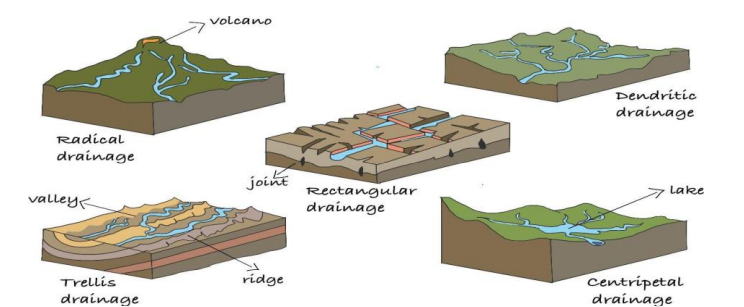
Types of Insequent Drainage System
| Type | Description | Example |
|---|---|---|
| Antecedent / Inconsequent | Rivers existed before uplift, maintained by downcutting | Indus, Ganga, Sutluj |
| Superimposed | Rivers imposed on new strata due to downcutting | Damodar, Chambal, Banas |
Drainage Patterns
| Pattern | Shape/Feature | Example |
|---|---|---|
| Dendritic | Tree-branch like | Indus, Mahanadi, Godavari |
| Trellised | Garden trellis-like, right-angle junctions | Seine (France) |
| Rectangular | Tributaries meet at steep angles | Chambal, Betwa, Ken |
| Radial/Centrifugal | Streams diverge from central high point | Ranchi upland (South Koel, Subarnarekha) |
| Centripetal | Streams converge to central depression | Lower Chambal basin |
| Annular/Circular | Circular arrangement around domes | Sonapet dome (Uttarakhand) |
| Parallel | Tributaries run parallel on uniform slope | Western Ghats rivers |
| Barbed | Tributaries flow opposite to mainstream | Arun River (Nepal) |
| Pinnate | Vein-like (leaf) | Upper Son, Narmada basin |
Mains Key Points
Prelims Strategy Tips
The Course of a River – Stages of River Development
Rivers pass through three distinct stages in their course – youth, mature, and old. Each stage is characterized by dominant erosion types, landforms created, and the river’s interaction with its slope, velocity, and sediment load.
Rivers pass through three distinct stages in their course – youth, mature, and old. Each stage is characterized by dominant erosion types, landforms created, and the river’s interaction with its slope, velocity, and sediment load.
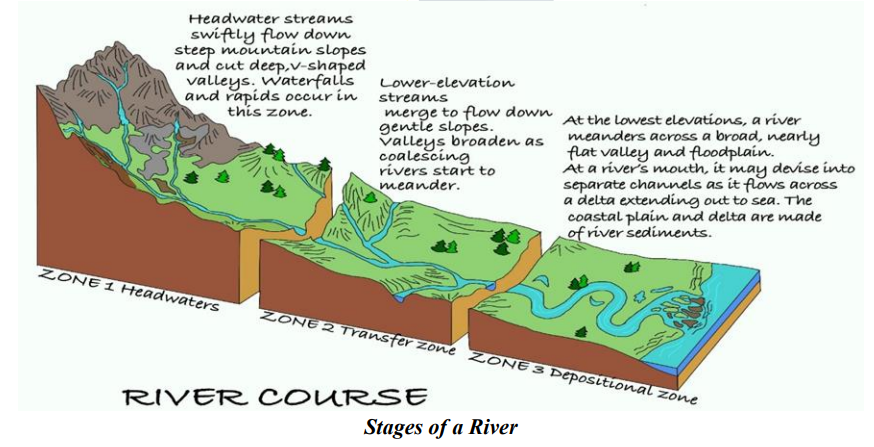
Stages of River Development
| Stage | Slope & Velocity | Dominant Erosion | Key Landforms |
|---|---|---|---|
| Youth Stage (Upper Course) | Steep slope, high velocity | Vertical erosion | V-shaped valleys, gorges, canyons, waterfalls |
| Mature Stage (Middle Course) | Gentle slope, moderate velocity | Lateral erosion > vertical erosion | Meanders, terraces, flood plains, levees |
| Old Stage (Lower Course) | Flat plain, low velocity | Deposition dominates | Deltas, distributaries, oxbow lakes, peneplain, monadnocks |
Mains Key Points
Prelims Strategy Tips
Processes of River Erosion and Erosional Landforms (Expanded)
River erosion operates through mechanical, chemical, and hydraulic processes that shape valleys and landscapes over time. These processes create distinct landforms such as valleys, gorges, canyons, waterfalls, rapids, potholes, plunge pools, terraces, and meanders. With increasing river maturity, these features evolve and provide insights into geomorphological history.
River erosion operates through mechanical, chemical, and hydraulic processes that shape valleys and landscapes over time. These processes create distinct landforms such as valleys, gorges, canyons, waterfalls, rapids, potholes, plunge pools, terraces, and meanders. With increasing river maturity, these features evolve and provide insights into geomorphological history.
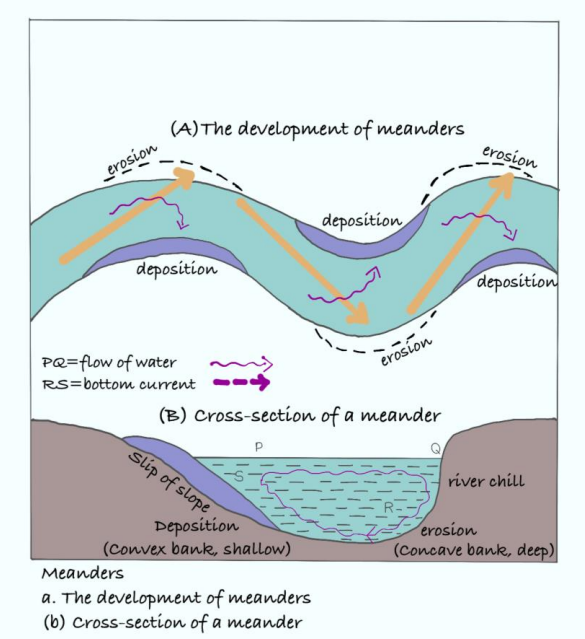
Processes of River Erosion
| Process | Description |
|---|---|
| Abrasion | Rock particles carried by river erode bed and banks |
| Solution | Dissolving of soluble minerals (carbonates) |
| Hydraulic Action | Breakdown of rocks by water force/pressure |
| Attrition | Sediments collide and break into smaller pieces |
Major Erosional Landforms of Rivers
| Landform | Formation Process | Example |
|---|---|---|
| River Valleys | Vertical or lateral erosion | Youth: V-shaped, Mature: U-shaped |
| Gorges | Deep narrow valleys by vertical erosion | Kali Gandaki Gorge |
| Canyons | Wider top, narrow base in sedimentary rocks | Grand Canyon (Colorado, USA) |
| Waterfalls | Sudden vertical fall due to resistant rock/fault/plateau edge | Niagara, Victoria Falls |
| Rapids | Unequal erosion in hard-soft rocks | Upper Ganga rapids |
| Potholes/Plunge Pools | Circular depressions by swirling pebbles at base of waterfalls | Common in rocky riverbeds |
| River Terraces | Flat surfaces representing old valley floors | Paired & Unpaired terraces |
| Meanders | Erosion on concave bank, deposition on convex bank | Incised meanders of Chambal |
Mains Key Points
Prelims Strategy Tips
Ox-Bow Lakes and River Rejuvenation
Ox-bow lakes are crescent-shaped lakes formed when a river abandons its meander loop. River rejuvenation occurs when rivers regain erosive power due to a fall in sea level or uplift of land, leading to renewed vertical erosion and terrace formation.
Ox-bow lakes are crescent-shaped lakes formed when a river abandons its meander loop. River rejuvenation occurs when rivers regain erosive power due to a fall in sea level or uplift of land, leading to renewed vertical erosion and terrace formation.
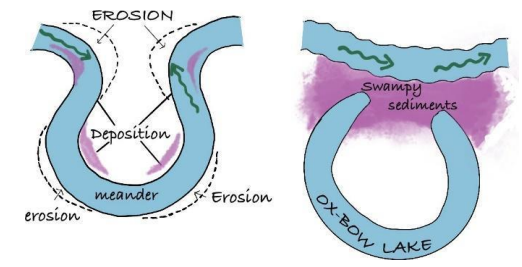
Comparison of Ox-Bow Lakes and River Rejuvenation
| Aspect | Ox-Bow Lakes | River Rejuvenation |
|---|---|---|
| Definition | Crescent-shaped lake formed from abandoned meander loop | Renewal of river erosive power due to fall in sea level/uplift |
| Stage | Occurs in old stage of river | Occurs when river shifts from mature/old back to youth |
| Cause | Erosion and deposition in meanders | Tectonic uplift, sea-level fall, climate change |
| Landforms | Horseshoe-shaped lake | Terraces, incised meanders, knick points |
| Example | Kanwar Lake (Bihar) | Ganga–Yamuna valleys with terraces |
Mains Key Points
Prelims Strategy Tips
River Transportation and Depositional Landforms
Rivers transport eroded material through traction, saltation, suspension, and solution. When the river loses energy, it deposits these sediments, forming distinctive landforms such as alluvial fans, cones, flood plains, levees, point bars, deltas, and braided channels.
Rivers transport eroded material through traction, saltation, suspension, and solution. When the river loses energy, it deposits these sediments, forming distinctive landforms such as alluvial fans, cones, flood plains, levees, point bars, deltas, and braided channels.
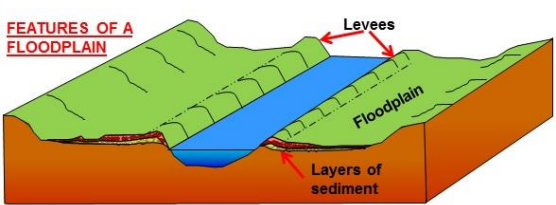
River Transportation Methods
| Method | Load Type | Description |
|---|---|---|
| Traction | Traction load | Heavy rocks roll/slide along bed |
| Saltation | Bedload | Medium particles hop along bed |
| Suspension | Suspended load | Fine particles carried in water |
| Solution | Dissolved load | Minerals dissolved in water |
Major Depositional Landforms
| Landform | Formation Condition | Example |
|---|---|---|
| Alluvial Fan/Cone | River descends from mountain to plain | Kosi River Fan (Bihar) |
| Flood Plains | Sediment deposition during floods | Indo-Gangetic Plain |
| Natural Levees | Sediment along riverbanks in floods | Mississippi River levees |
| Point Bars | Deposition at inner meander banks | Ganga meanders |
| Deltas | Sediment at river mouth with calm waters | Nile, Ganga-Brahmaputra, Mississippi |
| Braided Channels | Heavy load + reduced velocity | Brahmaputra in Assam |
Mains Key Points
Prelims Strategy Tips
Types of River Deltas
Deltas are depositional landforms formed at the mouths of rivers when sediment accumulates faster than it can be removed by tides, currents, or waves. Based on shape and formation processes, deltas can be classified into arcuate, bird-foot, estuarine, and cuspate types.
Deltas are depositional landforms formed at the mouths of rivers when sediment accumulates faster than it can be removed by tides, currents, or waves. Based on shape and formation processes, deltas can be classified into arcuate, bird-foot, estuarine, and cuspate types.
Classification of River Deltas
| Type | Shape/Features | Examples |
|---|---|---|
| Arcuate Delta | Arc or semi-circular, uniform deposition | Nile, Ganga-Brahmaputra, Rhine |
| Bird-foot Delta | Branches resemble bird’s foot, high sediment load | Mississippi (USA) |
| Estuarine Delta | Funnel-shaped in estuary, submerged mouth | Narmada, Tapi |
| Cuspate Delta | Pointed, tooth-shaped, wave action modifies | Tiber (Italy) |
Mains Key Points
Prelims Strategy Tips
Types of River Deltas
River deltas are depositional landforms formed at the mouths of rivers where sediment accumulates faster than it is removed. They vary in shape and structure due to the interaction of fluvial and marine processes. Common types include arcuate, bird-foot, estuarine, and cuspate deltas.
River deltas are depositional landforms formed at the mouths of rivers where sediment accumulates faster than it is removed. They vary in shape and structure due to the interaction of fluvial and marine processes. Common types include arcuate, bird-foot, estuarine, and cuspate deltas.
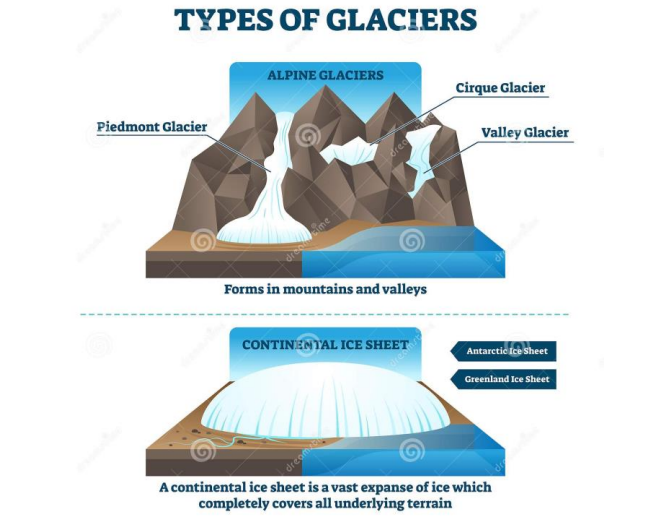
Major Types of River Deltas
| Type | Shape/Feature | Conditions | Examples |
|---|---|---|---|
| Arcuate Delta | Arc-shaped, semi-circular | Moderate tides and waves, uniform deposition | Nile, Ganga-Brahmaputra, Rhine |
| Bird-foot Delta | Claw-like branches | High sediment load, weak marine action | Mississippi |
| Estuarine Delta | Funnel-shaped in estuary | Submerged river mouths, estuary filling | Narmada, Tapi |
| Cuspate Delta | Pointed, tooth-like | River and strong wave interaction | Tiber |
Mains Key Points
Prelims Strategy Tips
Physical Characteristics of Glaciers and Processes of Glacial Erosion
Glaciers are large, moving masses of ice and debris that flow due to gravity and pressure. They move faster at the center and slower at the sides and bottom. Glacial erosion occurs mainly through plucking and abrasion, shaping unique landforms in highlands and depositing sediments in lowlands.
Glaciers are large, moving masses of ice and debris that flow due to gravity and pressure. They move faster at the center and slower at the sides and bottom. Glacial erosion occurs mainly through plucking and abrasion, shaping unique landforms in highlands and depositing sediments in lowlands.
Glacial Erosion Processes
| Process | Mechanism | Landforms Created |
|---|---|---|
| Plucking | Ice freezes in cracks, removes rock blocks | Steep cliffs, jagged rock surfaces |
| Abrasion | Rock debris scrapes bedrock | Striations, polished surfaces, U-shaped valleys |
Mains Key Points
Prelims Strategy Tips
Erosional Glacial Landforms
Glaciers carve landscapes through powerful processes of plucking and abrasion. Erosional landforms such as cirques, arêtes, pyramidal peaks, horns, roche moutonnee, and crag-and-tail structures are characteristic features of glaciated regions.
Glaciers carve landscapes through powerful processes of plucking and abrasion. Erosional landforms such as cirques, arêtes, pyramidal peaks, horns, roche moutonnee, and crag-and-tail structures are characteristic features of glaciated regions.
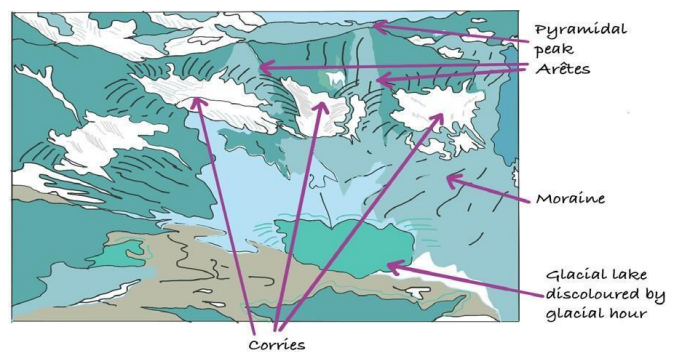
Comparison of Key Erosional Glacial Landforms
| Landform | Shape/Feature | Process | Example |
|---|---|---|---|
| Cirque | Bowl-shaped depression | Plucking & abrasion at mountain heads | Alps, Scotland |
| Arête | Sharp ridge | Erosion of adjacent cirques | Striding Edge (UK) |
| Pyramidal Peak | Pointed mountain top | Back-to-back cirque erosion | Matterhorn (Alps) |
| Horn | Single pyramidal peak | Cirques erode summit from all sides | Weisshorn (Switzerland) |
| Roche Moutonnée | Asymmetrical rock mound | Abrasion (gentle) & plucking (steep) | Norway, Canada |
| Crag and Tail | Crag = steep rock, Tail = gentle slope | Resistant rock protects leeward side | Castle Rock (Edinburgh) |
Mains Key Points
Prelims Strategy Tips
Glacial Troughs and Associated Landforms (Detailed)
As glaciers erode, transport, and deposit material, they transform pre-existing landscapes. Valleys once shaped by rivers become U-shaped troughs. Tributary glaciers form hanging valleys, depressions become ribbon lakes and rock basins, uneven erosion leads to rock steps, coastal glacial valleys form fjords, and the snout marks the dynamic front of the glacier.
As glaciers erode, transport, and deposit material, they transform pre-existing landscapes. Valleys once shaped by rivers become U-shaped troughs. Tributary glaciers form hanging valleys, depressions become ribbon lakes and rock basins, uneven erosion leads to rock steps, coastal glacial valleys form fjords, and the snout marks the dynamic front of the glacier.

Glacial Erosional Valley Features
| Landform | Key Feature | Example |
|---|---|---|
| U-Shaped Valley | Wide flat floor, steep sides | Yosemite Valley (USA) |
| Hanging Valley | Tributary valley above main trough, waterfalls | Himalayas, Alps |
| Ribbon Lake | Long narrow lake in trough depression | Lake Windermere (UK) |
| Rock Basin | Unequal excavation of bedrock | Great Lakes (partly glacial) |
| Rock Step | Step-like valley floor erosion | Alps |
| Fjord | Sea-filled U-shaped valley | Norwegian Fjords |
| Glacier Snout | Lowest visible end of glacier | Gangotri Snout (India) |
Mains Key Points
Prelims Strategy Tips
Depositional Glacial Landforms
When glaciers melt, they leave behind sediments ranging from fine clay to large boulders. These deposits form distinct landforms like moraines, drumlins, eskers, kettle lakes, kames, and outwash plains, which provide valuable insights into past glaciations.
When glaciers melt, they leave behind sediments ranging from fine clay to large boulders. These deposits form distinct landforms like moraines, drumlins, eskers, kettle lakes, kames, and outwash plains, which provide valuable insights into past glaciations.
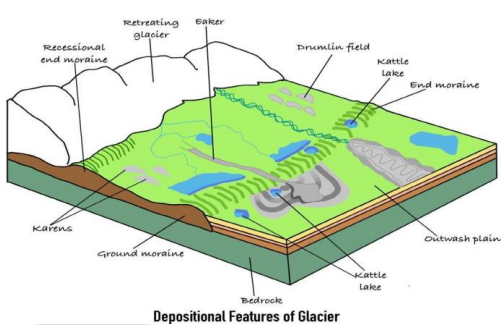
Depositional Glacial Landforms – Key Types
| Landform | Formation | Key Features | Example |
|---|---|---|---|
| Erratics | Large boulders transported by glacier | Different from local rock | Northern Europe |
| Moraines | Rock debris deposited by glaciers | Terminal, lateral, medial, ground | Alps |
| Drumlins | Till deposited under ice sheet | Oval, aligned with ice flow | Ireland |
| Eskers | Meltwater deposits in tunnels | Long sinuous ridges | Canada |
| Outwash Plains | Meltwater spreads sediments | Flat plains, stratified deposits | Iceland |
| Kettle Lakes | Ice blocks melt leaving depressions | Irregular, small lakes | Minnesota |
| Kames | Meltwater deposition near glacier | Rounded hills, hummocks | Scotland |
Mains Key Points
Prelims Strategy Tips
Action of the Wind and Aeolian Erosional Landforms (Detailed)
Wind in arid and semi-arid regions erodes land through abrasion, deflation, and attrition. This produces distinct landforms such as blow-outs, inselbergs, mushroom rocks, zeugens, yardangs, ventifacts, demoiselles, and wind bridges/windows. These features reveal the intensity and direction of past wind activity.
Wind in arid and semi-arid regions erodes land through abrasion, deflation, and attrition. This produces distinct landforms such as blow-outs, inselbergs, mushroom rocks, zeugens, yardangs, ventifacts, demoiselles, and wind bridges/windows. These features reveal the intensity and direction of past wind activity.
Detailed Wind Erosional Landforms
| Landform | Process | Key Feature | Example |
|---|---|---|---|
| Deflation Basin | Deflation removes sand | Large depression | Quattara Depression (Egypt) |
| Desert Pavement | Deflation of fines | Gravelly surface | Sahara Desert |
| Inselberg | Residual erosion | Steep isolated hill | Uluru (Australia) |
| Mushroom Rock | Abrasion at base | Narrow base, broad top | Sahara (Gara) |
| Zeugen | Erosion of softer strata | Flat-topped rock | Sahara |
| Yardang | Differential abrasion | Long ridges & troughs | Lut Desert (Iran) |
| Ventifact | Abrasion by sand | Faceted polished rocks | Kalahari Desert |
| Demoiselle | Caprock protection | Pillar with top cover | Alps |
| Wind Bridge | Enlarged window | Arch-like rock form | Arizona (USA) |
Mains Key Points
Prelims Strategy Tips
Wind Transportation and Deposition
Wind transports material through suspension, saltation, and creep, and deposits them when speed decreases or obstacles are encountered. This creates depositional landforms like ripple marks, sand dunes (various types), and loess plains.
Wind transports material through suspension, saltation, and creep, and deposits them when speed decreases or obstacles are encountered. This creates depositional landforms like ripple marks, sand dunes (various types), and loess plains.

Wind Deposition Landforms
| Landform | Formation | Key Features | Examples |
|---|---|---|---|
| Ripple Marks | Sand waves from shifting winds | Small undulations, transverse/longitudinal | Deserts worldwide |
| Transverse Dunes | Sand abundant, steady wind | Ridges perpendicular to wind | Sahara Desert |
| Barchans | Limited sand, steady wind | Crescent-shaped dunes | Thar Desert, Sahara |
| Longitudinal Dunes (Seifs) | Scarce sand, constant wind | Parallel dunes, km long | Namib Desert |
| Star Dunes | Multi-directional winds | Pyramidal with radiating arms | Rub al Khali Desert |
| Parabolic Dunes | Vegetation-stabilized sands | U-shaped, convex side upwind | Coastal deserts |
| Nebkhas | Obstacles like shrubs | Small sand mounds around plants | Thar Desert |
| Loess | Fine dust deposited by winds | Fertile, thick layers of silt | Loess Plateau (China), USA, Europe |
Mains Key Points
Prelims Strategy Tips
Fluvial-Desert Landforms
In deserts and semi-arid regions, running water (though limited) shapes landforms. Flash floods, wadis, badlands, mesas, buttes, playas, bolsons, pediments, and bajadas reflect the combined action of water and aridity.
In deserts and semi-arid regions, running water (though limited) shapes landforms. Flash floods, wadis, badlands, mesas, buttes, playas, bolsons, pediments, and bajadas reflect the combined action of water and aridity.
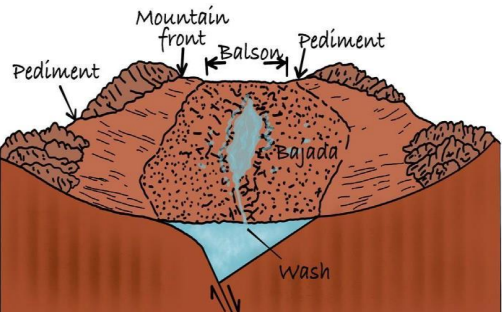
Fluvial-Desert Landforms
| Landform | Type | Formation | Example |
|---|---|---|---|
| Wadis | Erosional | Flash floods carve valleys | Sahara Wadis |
| Badlands | Erosional | Dense network of wadis | Chambal (India) |
| Mesa | Residual | Flat-topped table landform | Colorado Plateau (USA) |
| Butte | Residual | Smaller remnant of mesa | Monument Valley (USA) |
| Bolson | Structural | Intermontane basin | Basin & Range, USA |
| Playa | Depositional | Temporary lake in bolson | Lake Lap Nor, China |
| Pediment | Erosional | Gentle rock-cut slope | Arizona Desert |
| Bajada | Depositional | Merging alluvial fans | Death Valley, USA |
Mains Key Points
Prelims Strategy Tips
Action of Groundwater – Extended Notes
Groundwater not only stores and supplies fresh water but also shapes landscapes. Its chemical and mechanical actions lead to the development of unique landforms like caves, stalactites, stalagmites, sinkholes, and karst topography.
Groundwater not only stores and supplies fresh water but also shapes landscapes. Its chemical and mechanical actions lead to the development of unique landforms like caves, stalactites, stalagmites, sinkholes, and karst topography.
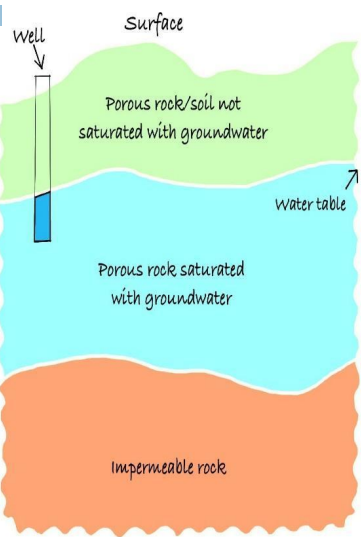
Groundwater Landforms
| Landform | Formation Process | Example |
|---|---|---|
| Caves | Solution of limestone | Ajanta-Ellora (India) |
| Stalactite | Deposition from cave roof | Mammoth Cave (USA) |
| Stalagmite | Deposition on cave floor | Postojna Cave (Slovenia) |
| Pillar | Union of stalactite & stalagmite | Carlsbad Caverns (USA) |
| Sinkhole | Collapse/dissolution depression | Florida (USA) |
| Karst Topography | Groundwater dissolution features | Karst Plateau (Slovenia) |
| Hot Spring | Geothermal-heated groundwater | Manikaran (India) |
| Geyser | Intermittent eruption of hot water | Old Faithful, Yellowstone (USA) |
Mains Key Points
Prelims Strategy Tips
Wells and Artesian Wells
Wells are man-made structures dug to access groundwater. They may be permanent or intermittent depending on their depth and water table level. Artesian wells, on the other hand, allow water to rise to the surface automatically due to hydraulic pressure in confined aquifers.
Wells are man-made structures dug to access groundwater. They may be permanent or intermittent depending on their depth and water table level. Artesian wells, on the other hand, allow water to rise to the surface automatically due to hydraulic pressure in confined aquifers.
Types of Wells
| Type | Description | Seasonal Availability |
|---|---|---|
| Permanent Well | Dug to permanent water table | All year round |
| Intermittent Well | Dug to seasonal water table | Only rainy season |
| Artesian Well | Confined aquifer under hydraulic pressure | Continuous until pressure reduces |
Mains Key Points
Prelims Strategy Tips
Springs
Springs are natural outlets of groundwater emerging at the surface. They form due to geological structures such as permeable and impermeable rock layers, faults, volcanic activity, or karst landscapes. Springs can be cold, hot, perennial, intermittent, or even geysers.
Springs are natural outlets of groundwater emerging at the surface. They form due to geological structures such as permeable and impermeable rock layers, faults, volcanic activity, or karst landscapes. Springs can be cold, hot, perennial, intermittent, or even geysers.
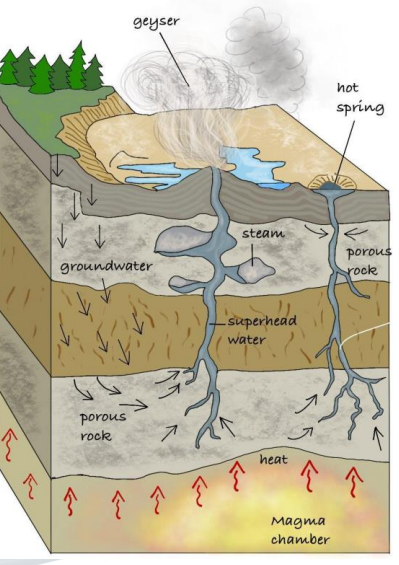
Types of Springs and Characteristics
| Type | Characteristics | Examples |
|---|---|---|
| Perennial Spring | Flows continuously year-round | Himalayan foothill springs |
| Intermittent Spring | Flows seasonally or at intervals | Semi-arid regions |
| Hot Spring | Geothermal heating, warm water | Rajgir, Bakreshwar, Sakhalin |
| Geyser | Intermittent eruption of hot water/steam | Old Faithful (USA) |
| Scarp-foot Spring | At fault or scarp bases, spring line | Western Ghats foothills |
| Vauclusian Spring | Karst regions, fountain-like flow | Fountain de Vaucluse (France) |
Mains Key Points
Prelims Strategy Tips
Karst Topography
Karst topography refers to unique landforms found in limestone and dolomite regions, shaped primarily by groundwater dissolution. It includes caves, sinkholes, dolines, and underground drainage systems. The term 'Karst' originates from the Karst region of former Yugoslavia.
Karst topography refers to unique landforms found in limestone and dolomite regions, shaped primarily by groundwater dissolution. It includes caves, sinkholes, dolines, and underground drainage systems. The term 'Karst' originates from the Karst region of former Yugoslavia.
Conditions for Karst Development
| Condition | Role |
|---|---|
| Limestone/Dolomite | Soluble rocks for dissolution |
| Rainfall | Provides water + CO₂ for carbonic acid |
| Surface Rocks | Allow percolation of water |
| Fractures/Faults | Enhance circulation of groundwater |
| Relief | Promotes underground drainage systems |
Mains Key Points
Prelims Strategy Tips
Karst Erosional Landforms
Karst erosional landforms are created by the chemical weathering and solutional action of groundwater on limestone and dolomite regions. These include depressions (sinkholes, dolines, uvalas, poljes), surface features (lapies, terra rossa), underground features (caves, ponors), and transitional forms like natural bridges.
Karst erosional landforms are created by the chemical weathering and solutional action of groundwater on limestone and dolomite regions. These include depressions (sinkholes, dolines, uvalas, poljes), surface features (lapies, terra rossa), underground features (caves, ponors), and transitional forms like natural bridges.
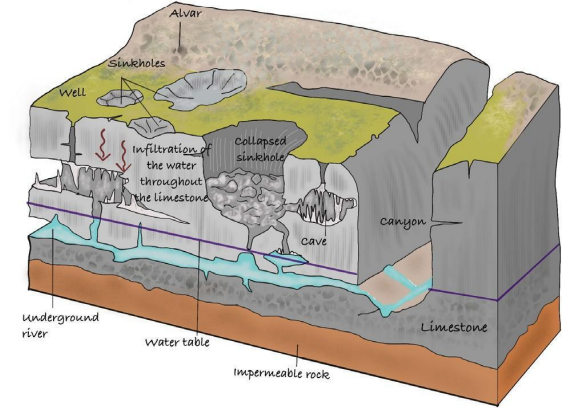
Karst Erosional Landforms – Key Examples
| Landform | Description | Example |
|---|---|---|
| Terra Rossa | Red clayey residual soil | Mediterranean Karst regions |
| Sinkholes | Funnel-shaped depressions | Common in limestone belts |
| Dolines | Large rounded depressions | Slovenia, Balkans |
| Poljes | Very large depressions | Livno Polje, Balkans |
| Caverns | Large underground caves | Carlsbad & Mammoth Caves (USA) |
Mains Key Points
Prelims Strategy Tips
Karst Depositional Landforms
Karst depositional landforms are created inside limestone caves due to precipitation of calcium carbonate from dripping groundwater. They include stalactites (roof deposits), stalagmites (floor deposits), and columns (when both join). Collectively, such cave formations are called speleothems.
Karst depositional landforms are created inside limestone caves due to precipitation of calcium carbonate from dripping groundwater. They include stalactites (roof deposits), stalagmites (floor deposits), and columns (when both join). Collectively, such cave formations are called speleothems.
Karst Depositional Features
| Feature | Location in Cave | Formation Process |
|---|---|---|
| Stalactite | Roof (ceiling) | Dripping water deposits calcite, hangs down like icicles |
| Stalagmite | Floor (ground) | Water drops deposit calcite on floor, grows upward |
| Column/Pillar | Spanning roof to floor | Stalactite and stalagmite join together |
| Flowstone | Walls and floors | Sheet-like calcite deposits from flowing water |
Mains Key Points
Prelims Strategy Tips
Action of Seawater
Seawater acts as a powerful geomorphic agent through waves, tides, and currents. Waves mainly cause erosion and deposition, tides aid deposition, and currents transport sediments. The interaction of these processes shapes coasts, shorelines, and coastal landforms.
Seawater acts as a powerful geomorphic agent through waves, tides, and currents. Waves mainly cause erosion and deposition, tides aid deposition, and currents transport sediments. The interaction of these processes shapes coasts, shorelines, and coastal landforms.
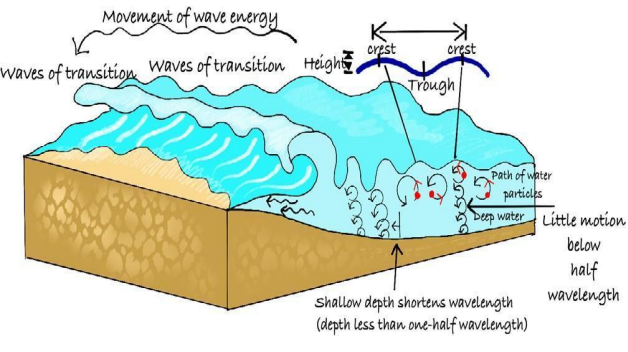
Comparison of Constructive and Destructive Waves
| Feature | Constructive Waves | Destructive Waves |
|---|---|---|
| Energy | Low | High |
| Frequency | 6–8 waves/minute | 10–14 waves/minute |
| Effect | Deposition, beach building | Erosion, cliff retreat |
| Swash vs Backwash | Swash stronger | Backwash stronger |
Mains Key Points
Prelims Strategy Tips
Types of Coastlines
Coastlines are classified based on tectonic, erosional, depositional, and sea-level change processes. They include coastlines of submergence, emergence, neutral, compound, and faulted types, each with distinct geomorphic characteristics.
Coastlines are classified based on tectonic, erosional, depositional, and sea-level change processes. They include coastlines of submergence, emergence, neutral, compound, and faulted types, each with distinct geomorphic characteristics.
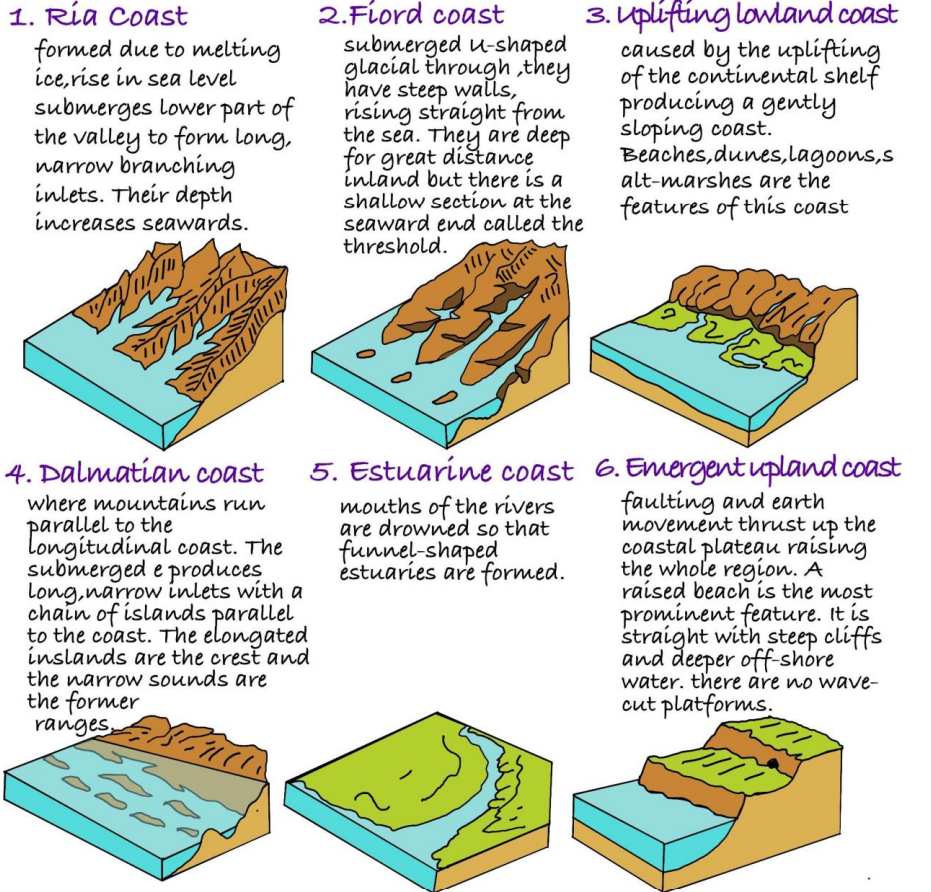
Types of Coastlines and Examples
| Type | Formation | Examples |
|---|---|---|
| Submergence (Ria) | Drowned river valleys | Ria de Aveiro (Portugal) |
| Submergence (Fiord) | Drowned glacial valleys | Norway, Alaska |
| Submergence (Dalmatian) | Submerged mountain ridges | Dalmatian Coast, Adriatic Sea |
| Emergence | Rising land or falling sea level | Konkan Coast, Coromandel Coast (India) |
| Neutral | Depositional processes | Ganga Delta, Coral Reef coasts |
| Compound | Emergence + Submergence | Norway, Sweden |
| Faulted | Submerged fault blocks | Santa Lucia Coast, California |
Mains Key Points
Prelims Strategy Tips
Processes of Marine Erosion and Coastal Erosional Landforms
Marine erosion is mainly caused by the action of waves, tides, and currents. Key processes include abrasion, attrition, solvent action, and hydraulic action. These processes create distinctive coastal erosional landforms such as cliffs, bays, capes, caves, arches, stacks, stumps, blowholes, and geos.
Marine erosion is mainly caused by the action of waves, tides, and currents. Key processes include abrasion, attrition, solvent action, and hydraulic action. These processes create distinctive coastal erosional landforms such as cliffs, bays, capes, caves, arches, stacks, stumps, blowholes, and geos.
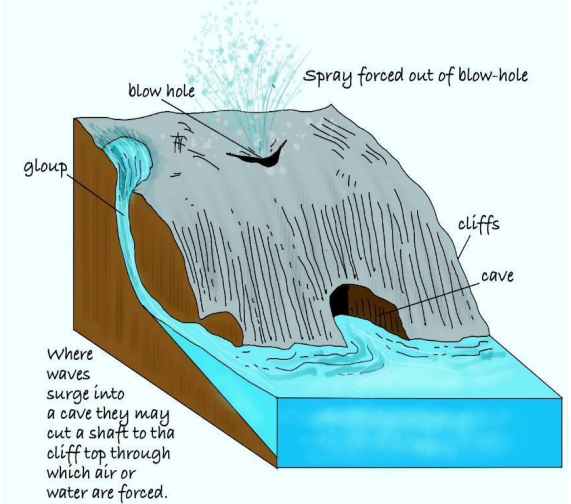
Marine Erosional Processes and Landforms
| Process | Description | Resulting Landforms |
|---|---|---|
| Abrasion | Waves grind rocks with sand/pebbles | Cliffs, wave-cut platforms |
| Attrition | Particles collide, become smooth/fine | Rounded pebbles, sand beaches |
| Solvent Action | Chemical dissolution of rocks | Limestone coasts, caves |
| Hydraulic Action | Wave pressure breaks rocks | Caves, arches, blowholes |
Mains Key Points
Prelims Strategy Tips
Chapter Complete!
Ready to move to the next chapter?
